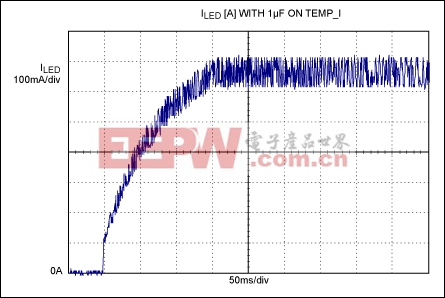Soft-start enhances LED driver
At start-up, 25µA flows into C2, which charges until its voltage reaches 25µA × RNTC. For an NTC value of 100kΩ and a capacitor value of 10nF, it should reach 2V in less than 2ms. That is, the LED current should ramp from 0mA to 666mA during those two milliseconds. Measurements confirm this assumption: a graph of LED current vs. time (Figure 3) shows that the driver settles to the maximum output current within 2ms.

Figure 3. In Figure 1, a graph of LED current vs. startup time with C2 = 10nF shows a soft-start interval of less than two milliseconds.
If you increase the capacitor value by a factor of 100 (to 1µF), the LEDs take about 200ms to reach full power (Figure 4). This timing is visible to the human eye, and gives a welcome sense that the LEDs need to warm up.

Figure 4. In Figure 1, a graph of LED current vs. startup time with C2 = 1µF shows a soft-start interval of ~200ms.
Using the thermal-foldback circuitry to implement a soft-start for LEDs does not interfere with its protection function. The big capacitor slows that function, but its operation remains satisfactory because thermal effects are inherently slow. Nor is the PWM dimming feature affected. Only the reference voltage is influenced; the rest of the driver behaves normally.
1
2
关键词: driver LED enhances Soft-start

加入微信
获取电子行业最新资讯
搜索微信公众号:EEPW
或用微信扫描左侧二维码